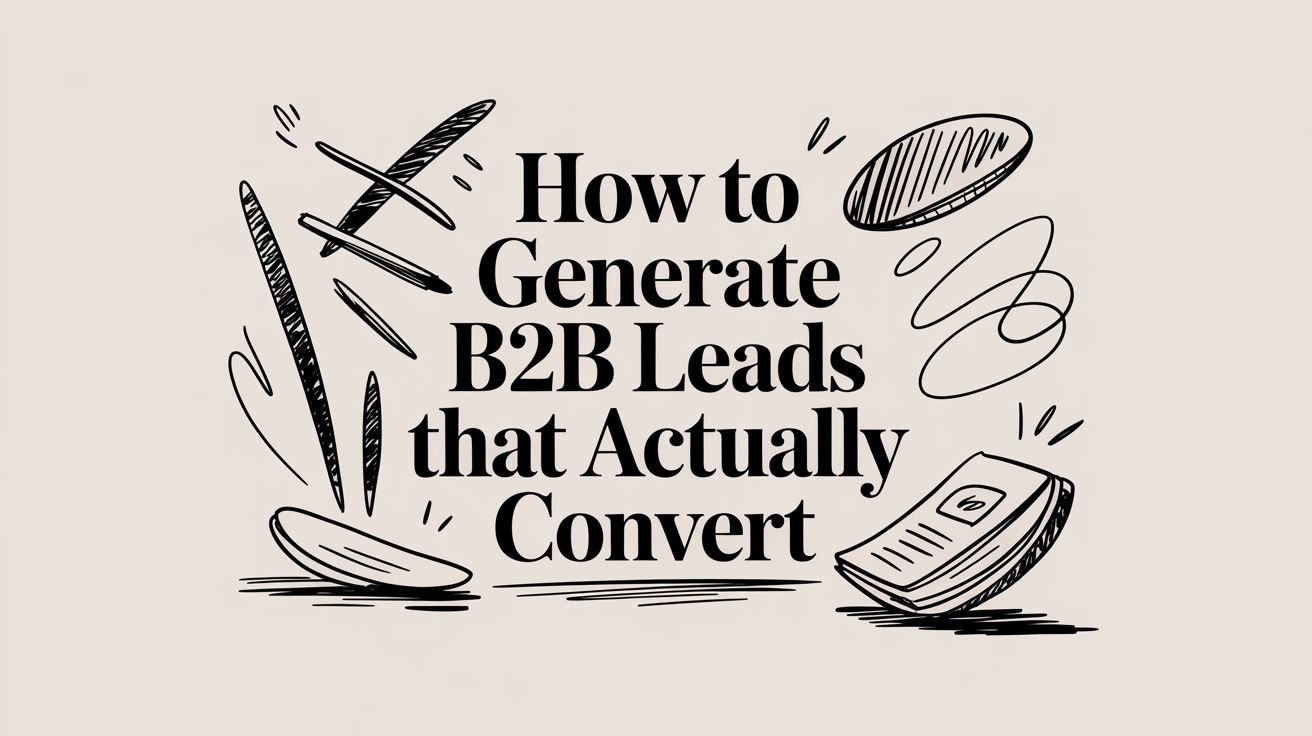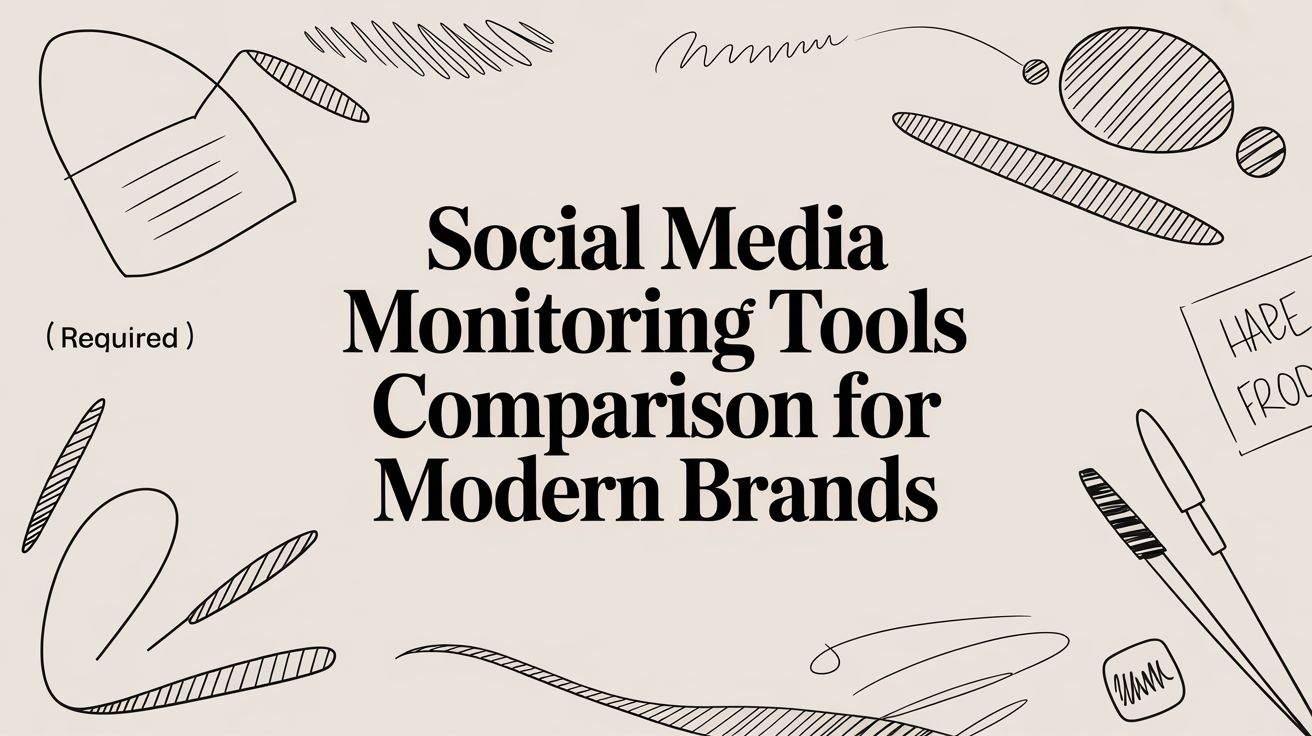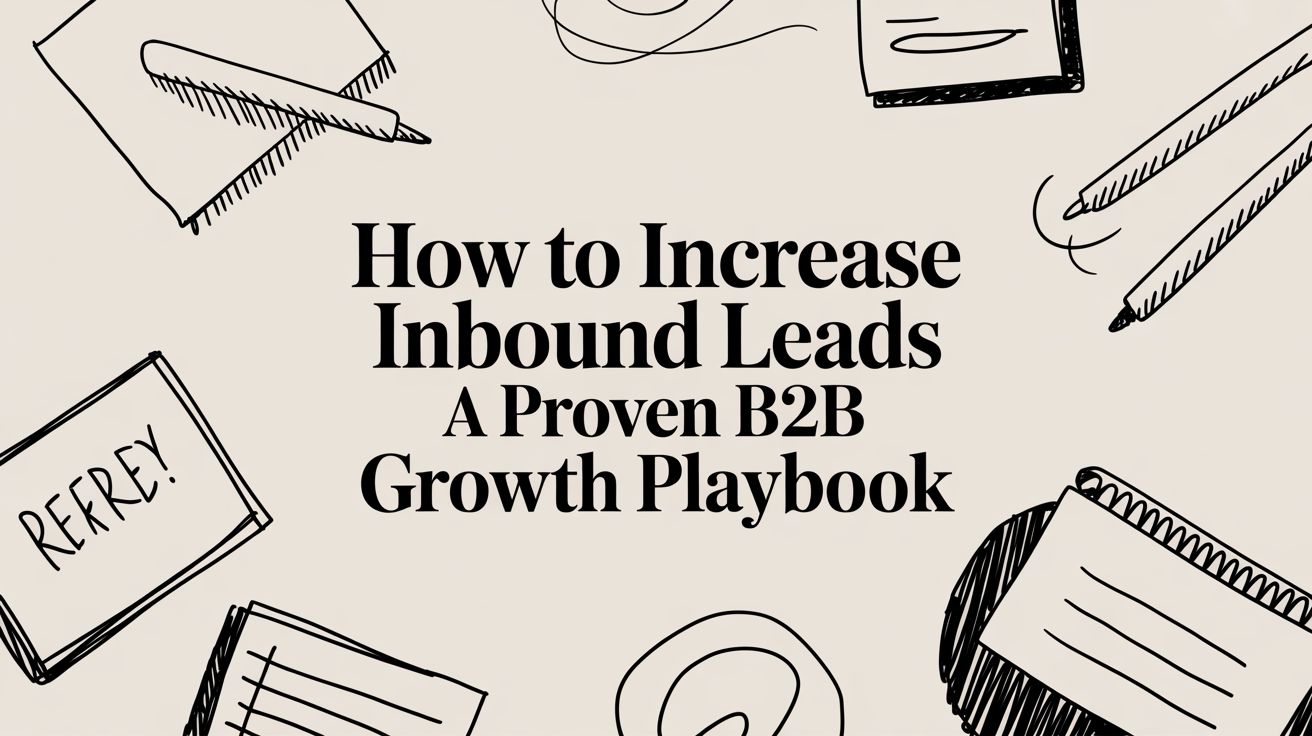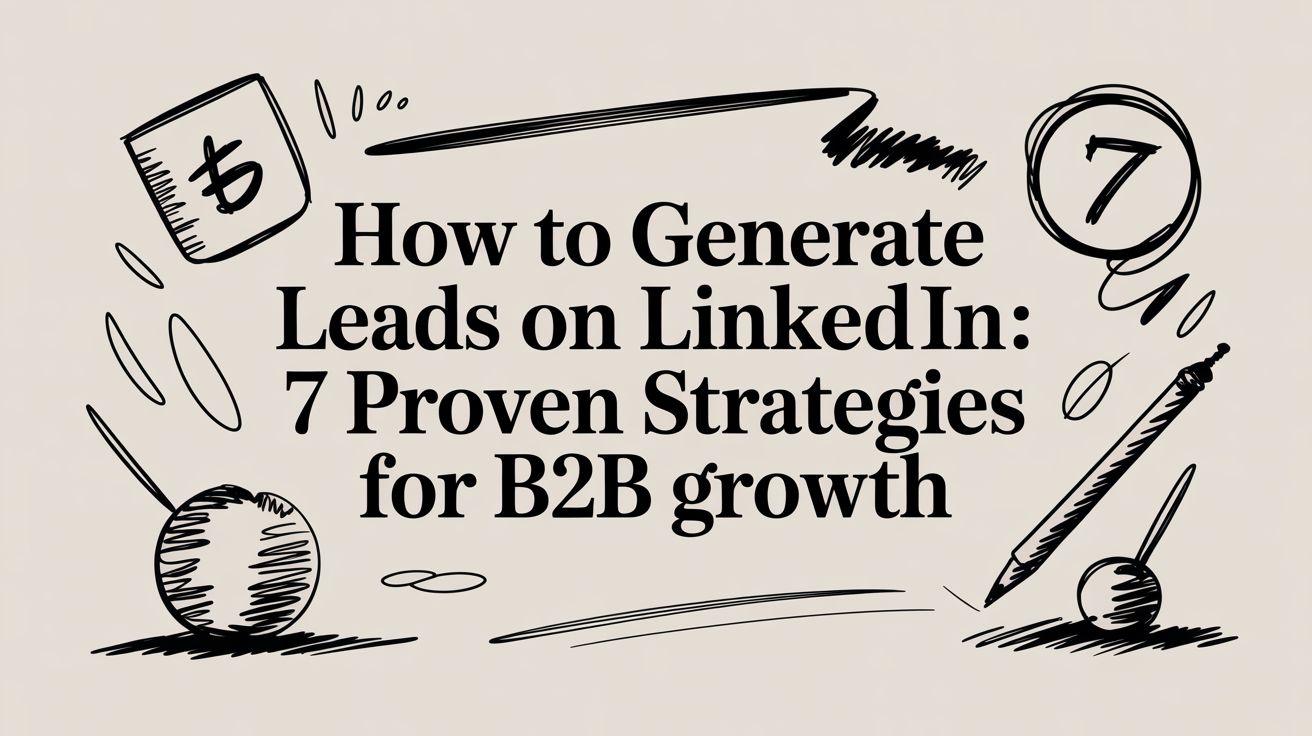Everything in B2B lead generation starts long before you ever send a message. The real secret is building a precise Ideal Customer Profile (ICP) and then setting up systems to listen for buying signals—the little flags that tell you a prospect actually needs what you're selling, right now.
Building Your Foundation for High-Quality Leads
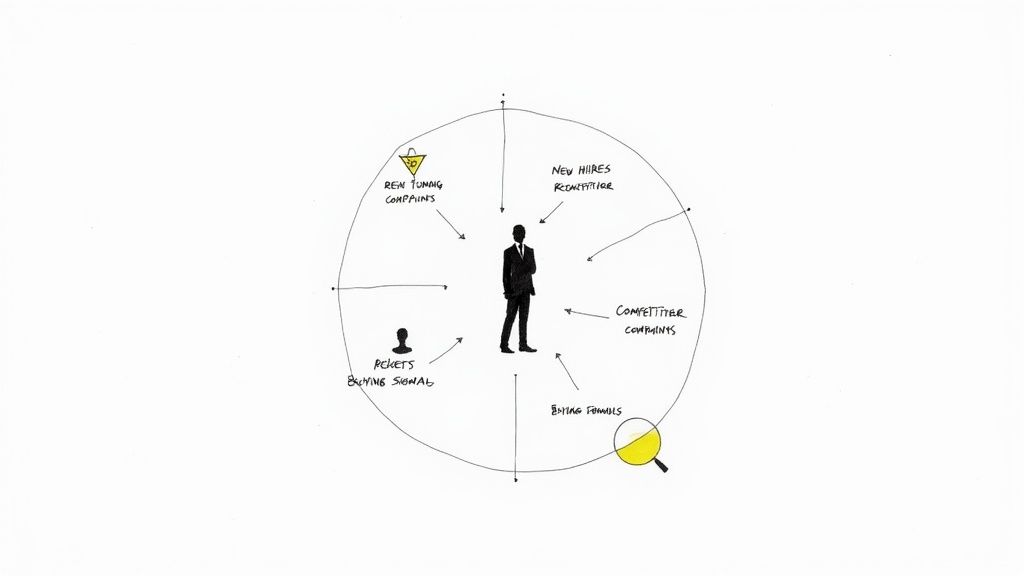
Most businesses burn through time and money chasing leads that were never going to convert. They take a shotgun approach, blasting their message out and hoping something sticks. This just leads to terrible reply rates and a demoralized sales team.
The best operators flip this model completely. Instead of shouting, they listen. They get incredibly good at spotting specific moments of need, which makes their outreach feel less like a pitch and more like a perfectly timed solution.
This foundational work is non-negotiable. Without a crystal-clear target and a way to spot timely opportunities, even the most cleverly written outreach templates will fall completely flat.
Moving Beyond Personas to a Precise ICP
A buyer persona is a good start. It might tell you you’re targeting "Marketing Mary," a 35-year-old manager at a mid-sized SaaS company. But an Ideal Customer Profile (ICP) digs so much deeper. If you're new to the concept, it's worth understanding what an Ideal Customer Profile (ICP) is.
Your ICP needs to define the exact kind of company that feels like your product was custom-built just for them.
A truly solid ICP breaks down a few key areas:
- Firmographics: The basics—industry, company size (both revenue and employee count), and where they're located.
- Technographics: What technology are they already using? Do they use a direct competitor or a tool that integrates perfectly with yours?
- Pain Points: Get specific. What operational friction, missed revenue, or strategic roadblocks are keeping their leadership team up at night?
- Business Goals: What are they trying to accomplish in the next quarter or year? Maybe they're expanding to a new market, trying to boost efficiency, or launching a new product.
Once you have a sharp ICP, you can instantly filter out 90% of the noise and pour all your energy into the accounts that actually matter.
Identifying Actionable Buying Signals
A buying signal is any event that screams, "This company is actively looking for a solution like yours!" These signals are the green light that turns a cold, random message into a relevant, timely conversation.
The goal isn't just to find the right company. It's to find the right company at the right time. Monitoring for buying signals is how you make your outreach feel like a helpful solution that arrived at the perfect moment.
Common signals are everywhere if you know what to look for. Think about a company announcing a new funding round (hello, new budget!), hiring for a key role (a new "Head of Sales" is going to need new tools), or an executive complaining about a competitor on social media. Recognizing these triggers is a cornerstone of modern lead gen—a practice that 91% of marketers consider their most important goal.
Setting Up Your Monitoring System
You don't need to spend a fortune on fancy software to start tracking these signals. In fact, a few simple, free tools can become your secret weapon when they're set up correctly. The whole idea is to build a simple system that brings these opportunities directly to you.
Here's a quick look at how you can set up alerts to catch some of the most common B2B buying signals.
Key B2B Buying Signal Monitoring Setup
| Buying Signal | Platform | Monitoring Keyword/Method |
|---|---|---|
| New Funding Round | Google Alerts, X | "[Target Industry]" + "series a funding" |
| Hiring Key Roles | LinkedIn, Google Alerts | "hiring" + "[Job Title]" + "site:linkedin.com/company" |
| Competitor Complaints | X, Reddit, Brand24 | "[Competitor Name]" + "alternative OR problem" |
| Industry Questions | Reddit, Quora | "[Your Solution Area]" + "how to OR recommend" |
Setting these alerts up takes less than an hour, but it can create a steady, reliable stream of warm opportunities. It ensures every single message you send is backed by real context and relevance.
For a deeper dive into executing these kinds of outreach plays, check out our other posts over at https://replymer.com/blog.
Mastering LinkedIn for a Consistent Lead Flow
Let's be honest, LinkedIn is the undisputed heavyweight for B2B prospecting. With over 875 million members, it’s the virtual office park where your ideal customers hang out. The problem? Most people treat it like a digital cold-calling list, blasting out generic connection requests and spammy pitches that are dead on arrival.
Forget the "spray and pray" approach. The real magic on LinkedIn isn't about volume—it's about precision, timing, and starting genuine conversations. We’re going to build a repeatable system that turns this professional network into your most reliable source of qualified leads.
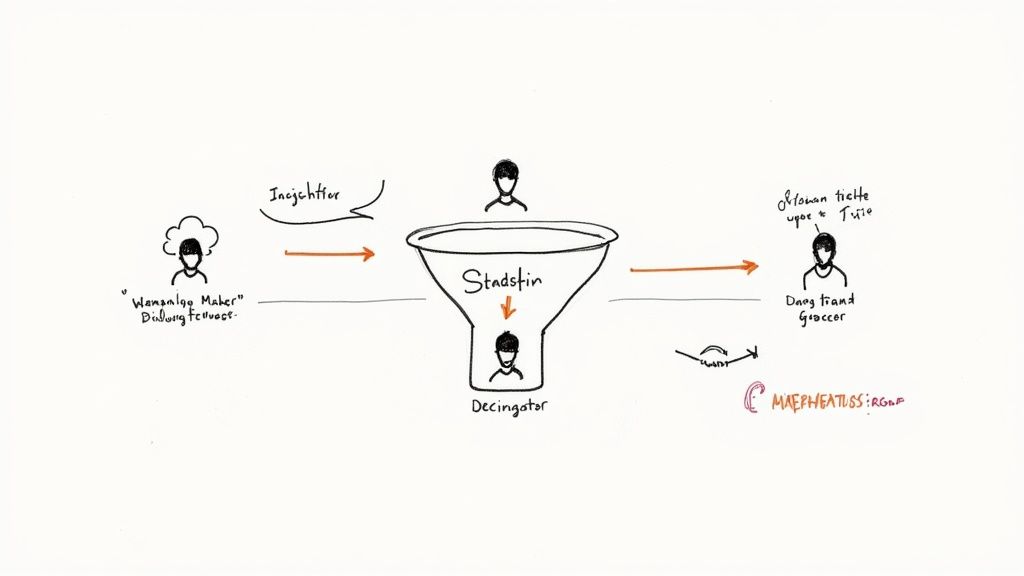
This is a glimpse inside LinkedIn Sales Navigator. The real power here isn't just filtering by job titles; it's about layering multiple filters to spot prospects based on recent company changes and online activity, giving you the perfect opening.
Going Pro with Sales Navigator for Hyper-Targeting
If you're serious about lead gen, a free LinkedIn account just won't cut it. Think of LinkedIn Sales Navigator as a non-negotiable investment. It turns LinkedIn from a social feed into a sophisticated search engine for pinpointing the exact decision-makers you need to talk to.
Instead of a generic search for "VP of Marketing," you can get incredibly specific.
- Lead Filters: Zero in on people who've changed jobs in the last 90 days, posted on LinkedIn in the last 30 days, or are following your company. A new exec is almost always looking to shake things up and bring in new tools.
- Account Filters: Find companies actively hiring for specific departments, undergoing leadership changes, or that just landed a new round of funding. These are all huge buying signals.
Let's say you sell project management software. You could build a saved search for "Directors of Operations" at "tech companies with 50-200 employees" who have "posted about productivity in the last 30 days." Boom. You now have a highly relevant list of active prospects and a perfect conversation starter.
The Warm-Up: Getting on Their Radar Before You Reach Out
Never, ever send a cold connection request. It’s the digital equivalent of walking up to a stranger at a conference and immediately pitching them. You need to show up on their radar a few times first, so when your name finally lands in their inbox, there's a flicker of recognition.
The goal is to shift their perception of you from "random salesperson" to "helpful industry peer." A single thoughtful comment is worth a hundred generic connection requests.
Warming up a prospect is simple and effective. Here’s how:
- Engage with their content. Find a recent post and leave a meaningful comment. Don't just type "Great post!" Add to the conversation. Ask a smart question or share a related perspective.
- Contribute to their groups. Find two or three LinkedIn Groups where your ideal customers are active. Jump in, answer questions, and share your expertise. This naturally positions you as a helpful authority.
- Mention a mutual connection. When you do send that request, referencing a shared connection or group can dramatically boost your acceptance rate.
This process takes a little more time upfront, but it pays off with a much higher connection rate and a warmer reception when you finally slide into their DMs. If you want to go deeper, check out these LinkedIn B2B lead generation strategies.
Crafting a Connection Request and First Message That Don't Get Ignored
Once you've warmed them up, it's time to make your move. Your outreach needs to feel personal and relevant. The goal is to start a conversation, not to close a deal on the spot.
You have a tight character limit for the connection request, so keep it short and sweet.
Connection Request Example: "Hi [Name], saw your post on [Topic] and your point about [Specific Detail] really resonated. Been following the great work you're doing at [Company Name] and would love to connect."
After they accept, your first DM is your chance to make a real impression. No product pitches! Lead with value and open a dialogue.
First Message Example: "Thanks for connecting, [Name]. That post you wrote about [Topic] got me thinking, and I thought you might find this article on [Related Subject] useful. We actually helped a company in the [Their Industry] space navigate that exact challenge recently. Just curious, is that a priority for your team this year?"
This approach works because it does three things perfectly: it references your previous interaction, gives them something valuable (the article), and finishes with a low-pressure, open-ended question. This is how you start real sales conversations on LinkedIn.
Finding Hidden Leads on X and Reddit
While LinkedIn is the go-to for buttoned-up B2B networking, some of the rawest, most immediate buying signals are actually happening on X (formerly Twitter) and Reddit. These are the digital town squares where people go to vent, ask for genuine recommendations, and air their frustrations. For you, every one of those posts is a potential lead.
The trick is to stop thinking like a salesperson and start acting like a helpful expert. You're not there to pitch; you're there to listen and solve problems. This builds a kind of trust that a cold email just can't, drawing prospects to you almost effortlessly.
Uncovering Opportunities with X Advanced Search
X is a constant, real-time firehose of information. The regular search bar is fine, but if you want to find serious leads, you need to be using X's Advanced Search. It’s the difference between shouting into a crowded room and walking right up to the one person who just asked for help.
You can get incredibly precise and filter out all the junk to find people who are practically raising their hands to buy.
- Hunt for purchase intent: Search for phrases like
"any recommendations for" + "[your software category]"or"looking for a tool that" + "[solves a specific problem]". - Find unhappy competitor customers: This is a goldmine. Use searches like
"[Competitor Name]" + "frustrated OR slow OR alternative". This will show you a list of people who are already fed up and probably looking to jump ship. - Keep it relevant: Use negative keywords (
-job,-hiring) to filter out noise. You can even filter by date or engagement levels to focus only on fresh, active conversations.
For instance, if you run a project management SaaS, a simple search for looking for a better alternative to asana could surface a real-time list of warm leads who have already decided they need a new solution. They've done half the work for you.
Navigating Reddit for Authentic Engagement
Reddit can feel like the wild west, but it’s an incredible place to find niche communities (subreddits) where your ideal customers hang out. With over 100,000 active communities, there’s a subreddit for almost any industry or professional role you can think of.
The golden rule on Reddit is simple: give, give, give before you even think about asking. Blatant self-promotion is the fastest way to get downvoted into oblivion and possibly banned.
Your strategy is all about becoming a trusted voice in the community.
- Find the right subreddits: Start by searching for your industry, your customers' job titles, or the problems you solve. A cybersecurity firm, for example, should be lurking in r/cybersecurity, r/netsec, and maybe even communities for IT managers like r/sysadmin.
- Listen first: Before you type a single word, just read. Get a feel for the culture. What kind of posts are popular? What are the recurring complaints? This is basically free market research.
- Offer real help: Look for threads where people are asking for advice. Jump in and give them a thoughtful, detailed answer without mentioning your company. The goal is to build a reputation as the go-to expert.
Here's a perfect example of a user in the r/saas subreddit asking for a recommendation—a crystal-clear buying signal.
This is a direct request for a solution. It's the perfect opening for a helpful reply that naturally leads them to discover what you do.
The best way to get leads on Reddit isn’t to post about your product. It’s to answer someone’s question so thoroughly that they get curious and click on your profile. Let your profile do the soft-selling with a link to your site.
Only after you’ve built up some goodwill should you even consider a subtle mention of your product, and only when it’s a perfect fit for the question. You could frame it like, "I've run into this a lot. One tool that's really good for [specific issue] is [Your Product], because it handles X and Y really well." It comes across as a helpful recommendation, not a sales pitch. That's how you win on Reddit.
Crafting Outreach That Gets a Reply
So you've done the hard work. You have a laser-focused list of prospects, and you know they have a problem you can solve. But all that research is for nothing if your first message sounds like every other automated pitch cluttering their inbox.
This is where the real art of B2B lead generation comes into play. The difference between getting ignored and starting a real conversation is simple: relevance. Your outreach has to instantly show you've done your homework, you understand their world, and you’re reaching out for a reason that actually matters to them.
The Give-Give-Ask Framework
Most B2B outreach falls flat because it immediately asks for something—a meeting, 15 minutes of their time, a demo. It’s a selfish approach that completely ignores the fact that you haven't earned a single second of their attention yet.
A far better way to build a connection is with the Give-Give-Ask framework. The concept is simple: provide value twice, with no strings attached, before you even think about asking for anything in return.
First Give: This is your opening move. It could be a thoughtful comment on their recent LinkedIn post, sharing a genuinely useful article that tackles a topic they've written about, or offering a quick, unique insight into a challenge you know their industry is facing. The goal is to be helpful, not salesy.
Second Give: Once they've replied or engaged, you follow up with another piece of value. Maybe it's a link to a non-gated case study (no forms!), an introduction to someone in your network who could help them, or a useful tip based on their reply.
The Ask: Only after you’ve established this micro-relationship built on value do you make a small, low-friction ask. You’re not trying to book a 30-minute demo. Instead, try something like, "Is this challenge something your team is prioritizing right now?"
This framework flips the entire sales dynamic. You’re giving, not taking. This naturally builds reciprocity and positions you as a helpful expert, not just another salesperson with a quota.
Hyper-Personalization That Actually Works
Let's be clear: personalization is more than just plugging [First Name] into a template. Real personalization proves you see the individual behind the job title. It's about connecting your solution to their world, right now.
The most effective way to do this is by referencing their recent, specific activity.
- On Their Content: "Hi [Name], I saw the talk you gave at [Conference Name] about scaling customer support teams. Your point about preventing agent burnout was spot on."
- On Their Company's News: "Congrats to the team at [Company Name] on the new product launch! I imagine a big priority now is ensuring a smooth onboarding experience for all those new users."
- On Their Expressed Pain Points: "I noticed your comment on Reddit about the challenges of integrating your CRM with your marketing platform. We've seen that exact issue cripple campaign reporting for similar companies."
The best outreach feels less like an interruption and more like a continuation of a conversation they were already having, either publicly or inside their own head. Your message should be the missing puzzle piece they didn't know they were looking for.
Outreach Template Comparison: Good vs. Bad
The gap between a message that works and one that gets deleted is massive. Putting them side-by-side makes it obvious what to do—and what to avoid at all costs.
| Outreach Element | Ineffective Example (Avoid) | Effective Example (Use) |
|---|---|---|
| Opening Line | "Hi, my name is John and I work at XYZ Corp. We are a leading provider of..." | "Hi Jane, I saw your post on X about struggling with project visibility. It really hit home." |
| Value Proposition | "...our innovative, synergistic platform leverages AI to streamline workflows." | "We helped a similar SaaS firm cut their reporting time in half by automating that exact process." |
| Call to Action | "Are you available for a 15-minute demo next week?" | "Is improving project visibility a priority for your team this quarter?" |
Notice how the bad examples are all about the sender—"my name," "we are," "our platform." They’re generic, packed with jargon, and jump straight to a selfish ask. The good examples are entirely focused on the recipient—"your post," "your team," "that exact process." They are specific, empathetic, and open a conversation with a low-pressure question.
Considering that 85% of B2B marketers see lead generation as their biggest challenge, getting this message right isn’t just a good idea—it’s everything.
Scaling and Measuring Your Lead Gen Engine
Pulling off a few successful outreach plays feels great, but it’s not a sustainable growth strategy. The real magic happens when you turn those one-off wins into a predictable, repeatable system—a true lead gen engine. This is where you stop just doing the work and start measuring what works so you can scale it intelligently.
One-off tactics are exhausting. You're constantly hunting for the next lead. A scalable engine is like building a farm; it provides a reliable source of opportunities, letting you forecast your pipeline and make smart decisions about where to invest your time and money.
The first step? Tracking the right numbers. Forget vanity metrics like impressions or connection requests. They don't pay the bills.
Pinpointing the KPIs That Actually Matter
To really scale your B2B lead generation, you need to get past gut feelings and focus on the data. A handful of key performance indicators (KPIs) can tell you the whole story of your outreach effectiveness, from the first touchpoint to a closed deal.
These are the core metrics that should live on your dashboard:
- Reply Rate: This is your first and most important signal. Is your message even landing? A low reply rate usually means your targeting is off or your opening line is falling flat. Make sure to track this by channel (LinkedIn vs. X vs. Reddit) to see where you're getting the most traction.
- Positive Reply Rate: Let's be honest, not all replies are good news. This metric cuts through the noise of "not interested" responses to show you how many conversations are actually moving in the right direction. It's a fantastic health check for your lead quality.
- Meeting Booked Rate: This is where the rubber meets the road. How many of those positive replies are turning into actual sales meetings? This KPI connects your outreach directly to a tangible sales outcome.
- Sales Cycle Length by Channel: You might be surprised by what you find here. How long does it take for a lead from Reddit to close compared to one from LinkedIn? Knowing this helps you pour resources into the channels that deliver faster wins.
Tracking these numbers uncovers some powerful insights. For instance, you might find that LinkedIn gets you a higher overall reply rate, but the leads you source from X have a 25% shorter sales cycle. That’s a game-changer if you’re trying to hit quarterly targets.
Your dashboard doesn't need to be some complex, over-engineered spreadsheet. It just needs to be a single source of truth that tells you, at a glance, what’s working, what's broken, and where your best opportunities are.
A core principle that directly boosts these numbers is the "Give-Give-Ask" framework. It’s simple but incredibly effective.
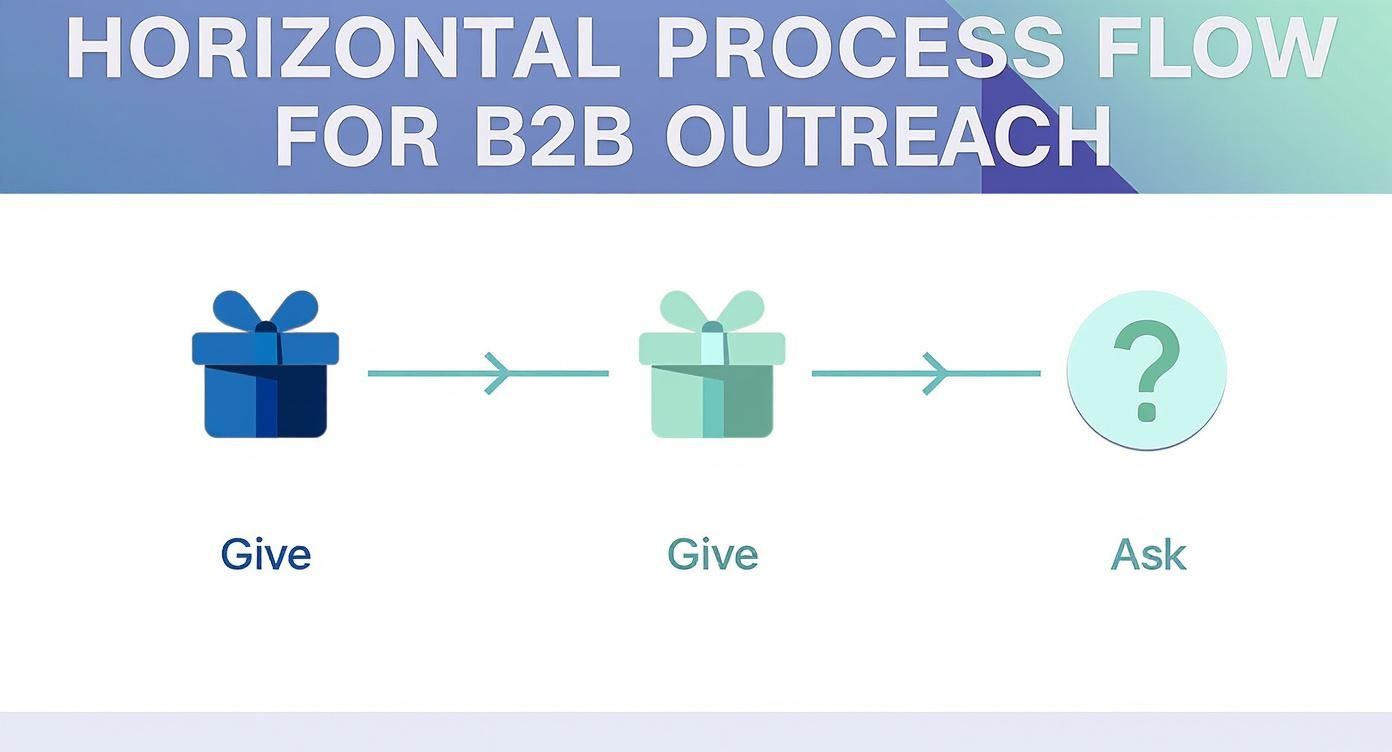
The idea is to lead with value, building enough trust to turn a cold prospect into a warm conversation. This is fundamental to getting better replies and booking more meetings.
Introducing Automation Responsibly
As you start to scale, you can't be everywhere at once. Manually monitoring every keyword or updating every CRM record just isn't feasible. Automation becomes essential, but it should be used to enhance the human element, not replace it. The goal is to automate the machine, not the conversation.
Here’s how to bring in automation without sounding like a robot:
- Automate Your Listening: Set up tools to monitor your keywords across platforms 24/7. This stops you from having to constantly search and ensures you never miss a conversation. The tool finds the opening; you step in with the human touch.
- Streamline Your Data Entry: Connect your outreach tools directly to your CRM to log activities automatically. This is a huge time-saver and keeps your lead data clean and up-to-date without the manual headache.
- Use Snippets, Not Full Templates: Blasting out generic, fully-automated messages is a recipe for failure. Instead, build a library of text snippets for common talking points or value props. This speeds up your workflow but still forces you to personalize the most important parts of the message—the opener and the closing.
For teams that want to jump straight to the results, a service like Replymer can run this entire playbook for you. They handle the monitoring, filtering, and even the human-written replies, letting your team focus only on the high-value conversations that come out of it. It’s the perfect blend of automation’s efficiency and the personal touch that actually closes deals.
Common B2B Lead Generation Questions Answered
Even with the best playbook in hand, you're going to have questions once you start putting a new B2B lead generation strategy into action. It's only natural. The practical side of things—like figuring out a budget and how long this will all take—is where the rubber meets the road.
Let's walk through some of the most common questions I hear from teams who are just getting started. Getting these answers straight will help you set realistic goals and keep your team from giving up before you see real results.
How Much Should We Budget for Outreach?
So many people get this wrong. They think they need a huge war chest for ads right out of the gate. But for this kind of outreach, your biggest investment isn't cash—it's time. The real cost is the focused human effort it takes to monitor conversations and write genuinely helpful, personalized replies.
A smart starting budget looks something like this:
- Essential Tools: You'll need a subscription for a good social listening tool and probably a sales intelligence platform. These are your non-negotiables.
- Time Allocation: The biggest line item is simply blocking out dedicated hours each week for your team to actually do the work.
That’s it. Don't overcomplicate it. Your budget should be all about enabling consistent, high-quality human interaction. Once the results start rolling in, you can think about scaling up your tools and team.
You don't need a huge budget to start; you need a focused commitment. The initial cost is measured more in disciplined hours than in dollars. Prioritize consistency over expensive, complex software.
How Long Until We See Consistent Results?
This is a marathon, not a sprint. If you're looking for instant gratification, go buy some ads. This conversation-driven approach is all about building relationships and earning trust, and that simply takes time. The good news is that the results compound as your credibility grows on each platform.
Here’s a realistic timeline to keep in mind:
- Months 1-2: This is your learning and setup phase. You’ll be fine-tuning your ideal customer profile, getting your monitoring dialed in, and just practicing your outreach. Expect a few initial replies, but treat them mostly as feedback to see what messaging works.
- Months 3-4: By now, you should be seeing a more predictable trickle of positive responses and even booking your first few meetings. Your team will have developed a knack for spotting good opportunities quickly.
- Months 5+: This is when things should really start humming. You ought to have a consistent, measurable flow of qualified leads dropping into your pipeline every single month.
Patience is everything here, and you have to track your data from day one. If you're not seeing any positive signals by the end of month three, it’s time to take a hard look at your targeting and messaging.
And for those looking to add another growth lever, partnerships can be a great way to speed things up. To see how this works, you can learn more about the Replymer affiliate program and how it can complement your direct outreach efforts.
Ready to turn social conversations into a predictable stream of qualified leads without the manual effort? Replymer acts as your done-for-you growth engine. We monitor, filter, and write human-first replies to get your brand recommended in the right conversations, driving demand on autopilot. See how it works at https://replymer.com.
